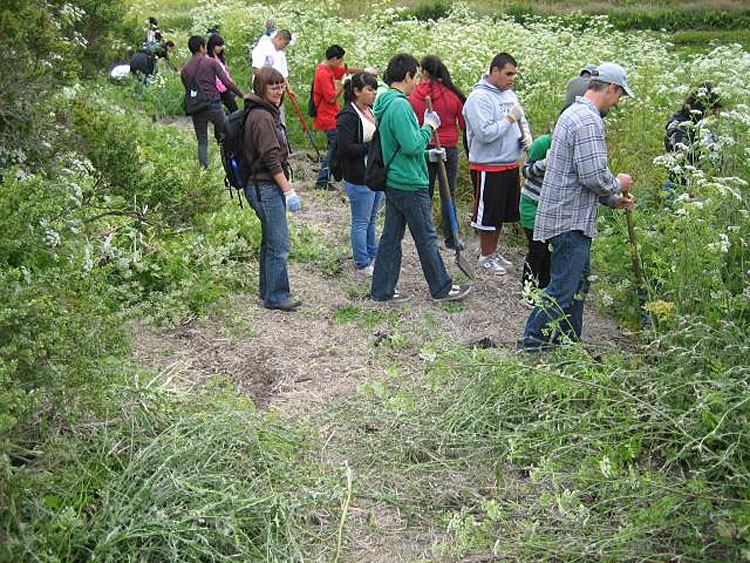Springtime in the Wetlands
Yellow Willow
 Spring is a good time to visit the wetlands because of the many blooming plants. Among them you will find several varieties of willows. Willows can be hard to tell apart. Both the red willow and the yellow willow are trees that grow at the water’s edge and have leaves with long tapering tips. To identify the yellow willow look for the small bumps or glands found at the base of the leaf blade.
Spring is a good time to visit the wetlands because of the many blooming plants. Among them you will find several varieties of willows. Willows can be hard to tell apart. Both the red willow and the yellow willow are trees that grow at the water’s edge and have leaves with long tapering tips. To identify the yellow willow look for the small bumps or glands found at the base of the leaf blade.
Most flowering plants have both male and female reproductive parts on the same plant, but willows have them on separate plants. The male willows produce beautiful yellow flowers that disperse pollen both by wind and insects. The female willows produce copious quantities of tiny seed borne on the wind by white fluff. If these seeds chance to land on some wet soil they can germinate and grow.
Willows also have the ability to reproduce from branches that break off and get stuck in the mud. These bare branches can develop new roots and leaves. Because of this ability willow cuttings are often used in habitat restoration. The annual sprouts of willows are exceedingly strong and flexible, and are often used in basket weaving.
Earth Day Event: Saturday Community Restoration
 Saturday, April 22: we invite you to help restore wetland habitat as part of our celebration of Earth Day. We will work from 9 a.m. to noon, and we always make time for birding or a short hike around the wetlands. We supply the gloves, tools, and yummy snacks.
Saturday, April 22: we invite you to help restore wetland habitat as part of our celebration of Earth Day. We will work from 9 a.m. to noon, and we always make time for birding or a short hike around the wetlands. We supply the gloves, tools, and yummy snacks.
Meet at our Fitz Wetlands Educational Resource Center (map/directions). If you have questions, please contact Mary Paul at [email protected] or 831-566-4938.
International Migratory: Bird Day Celebration
Saturday, May 13: Join us when we celebrate International Migratory Bird Day 2017! When birds migrate between nesting and wintering sites, they don’t just stop anywhere; they rely on a handful of resource-rich and strategically located sites where they may double their body weight as they acquire the energy-rich fat stores needed to fly thousands of kilometers across continents and oceans.
These places are known as stopover sites. The wetlands along the Central Coast, including Watsonville Wetlands, provide crucial habitat for migrating and resident birds.
Watsonville Wetlands Watch is hosting two bird watching walks on Saturday, May 13, from 8 a.m. to 10 a.m. Nanci Adams will lead a walk along the paved East Struve Slough trail that is wheelchair accessible and will see some of our restoration work in progress.
Hugo Ceja’s walk across Department of Fish and Wildlife lands to West Struve Slough requires walking over some uneven terrain and is a great venture out into one of the more wild areas of the Watsonville Slough System. Wear layers, bring binoculars, hat, sunscreen, and water.
Both trips will meet at the Wetlands Educational Resource Center map/directions. Car caravans will leave from there for each tour. Admission is free but you must reserve a seat online by clicking here. For more information, contact Debbie Diersch at [email protected].
Presentation: Climate Change and Impacts on the Monterey Bay Area
 Wednesday, May 17: Gary Griggs, UCSC Professor of Earth Sciences and Director of the Institute of Marine Sciences, will discuss climate change and provide a view into what we can expect in our local area.
Wednesday, May 17: Gary Griggs, UCSC Professor of Earth Sciences and Director of the Institute of Marine Sciences, will discuss climate change and provide a view into what we can expect in our local area.
Our climate is changing and is being driven in large part over the past century by the increasing emission of greenhouse gases from the burning of fossil fuels.
Worldwide temperatures in 2016 were the hottest on record, and arctic ice is melting and sea level is rising. How will the climate changes we are experiencing affect the Monterey Bay area in the years ahead?
•••
This talk, hosted by the Watsonville Wetlands Watch, is from 6:30 to 8:30 p.m. at the Fitz Wetlands Educational Resource Center. Click for map/directions. Admission is free but you must reserve a seat online by clicking here. For more information, contact Kathy Fiebering at 831-345-1226 or [email protected].

